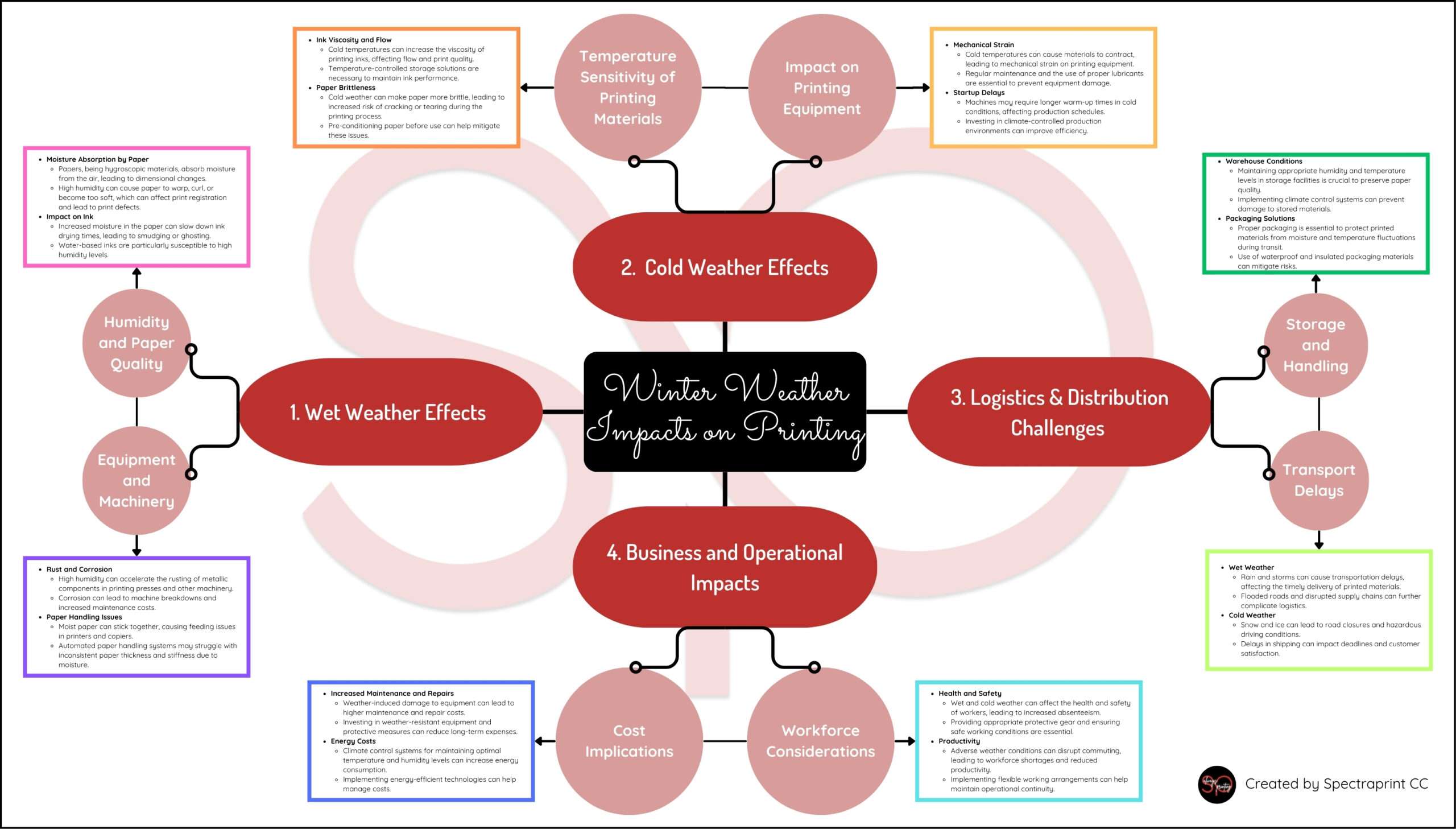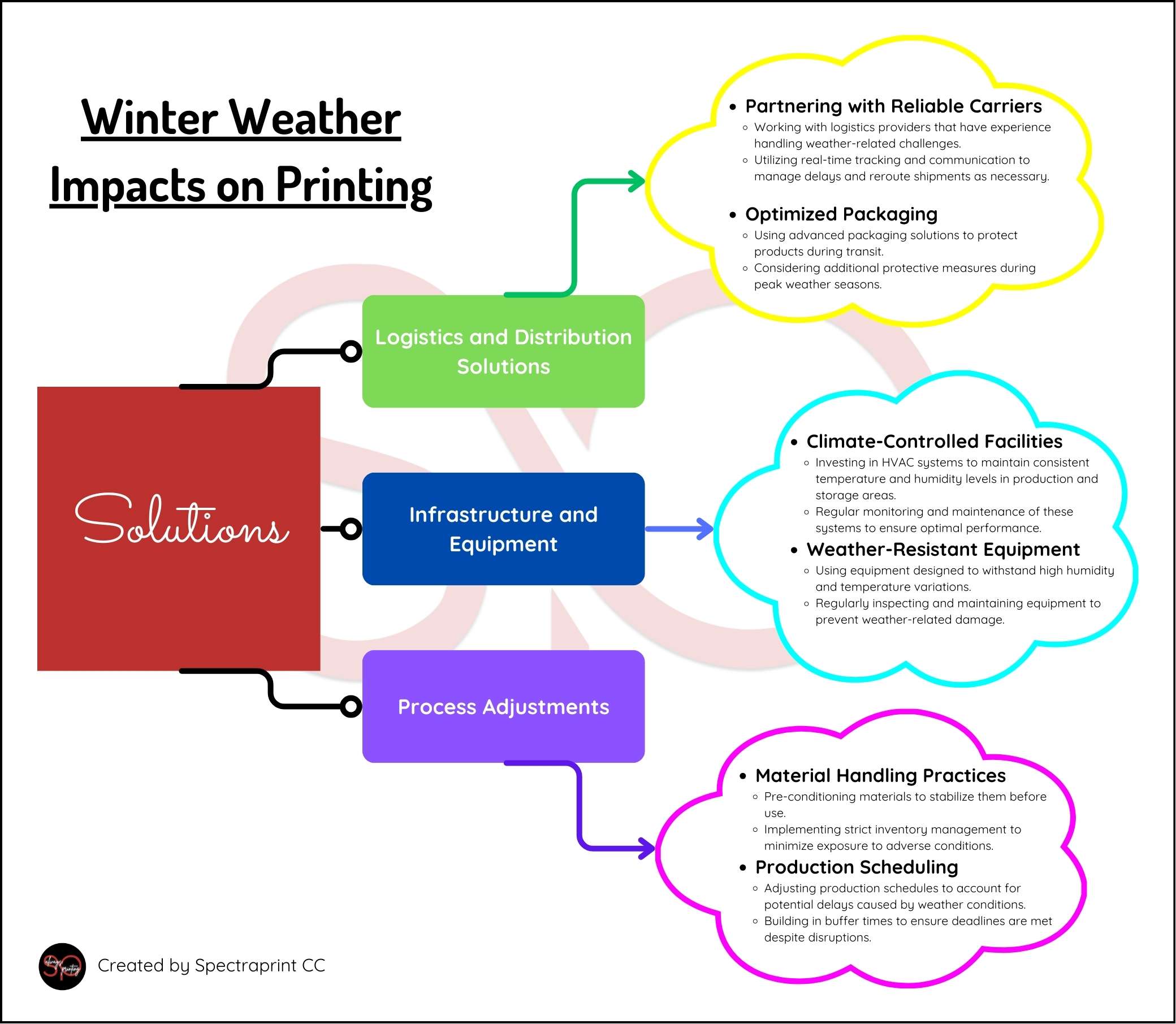Weather patterns significantly influence various industries, and the printing industry is no exception. Wet and cold weather can have both direct and indirect effects on printing companies, from the production process to distribution and overall business operations. As we can see currently in Cape Town, our winter weather impacts on printing! Understanding these impacts is crucial for printing companies to develop strategies that mitigate adverse effects and ensure consistent quality and delivery of printed materials. This blog post explores the myriad ways wet and cold weather can impact the printing industry and provides insights into best practices for managing these challenges.
Click here if you want to skip the longer article to the key points!
1. Effects of Wet Weather on Printing Processes
1.1 Humidity and Paper Quality
Moisture Absorption by Paper
Papers, being hygroscopic materials, absorb moisture from the air, leading to dimensional changes. This absorption can cause the paper to expand or contract, impacting its overall quality and usability in printing processes. High humidity can cause paper to warp, curl, or become too soft, which can affect print registration and lead to print defects. For instance, paper that has absorbed too much moisture might not feed correctly through printing presses, causing jams and misalignment issues.
Impact on Ink Absorption and Drying
Increased moisture in the paper can slow down ink drying times, leading to smudging or ghosting. This is particularly problematic for high-speed printing operations where quick drying is essential to maintain production efficiency. Water-based inks are particularly susceptible to high humidity levels, as the additional moisture can interfere with the ink’s ability to bond properly with the paper fibers. This can result in blurred images and text, reducing the quality of the final printed product.
1.2 Equipment and Machinery
Rust and Corrosion
High humidity can accelerate the rusting of metallic components in printing presses and other machinery. Rust can not only deteriorate the machinery but also lead to operational inefficiencies and increased maintenance costs. Corroded parts may need frequent replacement, which can disrupt production schedules and increase operational expenses.
Paper Handling Issues
Moist paper can stick together, causing feeding issues in printers and copiers. This can lead to paper jams and increased downtime as operators need to manually separate and reload the paper. Automated paper handling systems may struggle with inconsistent paper thickness and stiffness due to moisture, leading to further operational challenges and reduced productivity.
2. Effects of Cold Weather on Printing Processes
2.1 Temperature Sensitivity of Printing Materials
Ink Viscosity and Flow
Cold temperatures can increase the viscosity of printing inks, affecting flow and print quality. Viscous inks do not spread evenly, which can result in uneven print coverage and color inconsistencies. Temperature-controlled storage solutions are necessary to maintain ink performance. By keeping inks at optimal temperatures, printers can ensure consistent flow and high-quality prints.
Paper Brittleness
Cold weather can make paper more brittle, leading to an increased risk of cracking or tearing during the printing process. This brittleness can cause problems in high-speed printing environments where paper flexibility is crucial for smooth operation. Pre-conditioning paper before use, by bringing it to a stable room temperature, can help mitigate these issues and ensure smooth printing processes.
2.2 Impact on Printing Equipment
Mechanical Strain
Cold temperatures can cause materials to contract, leading to mechanical strain on printing equipment. This contraction can affect the alignment and operation of moving parts, potentially causing breakdowns or malfunctions. Regular maintenance and the use of proper lubricants are essential to prevent equipment damage. Ensuring that equipment is regularly inspected and maintained can help mitigate the adverse effects of cold weather.
Startup Delays
Machines may require longer warm-up times in cold conditions, affecting production schedules. Cold machinery takes longer to reach optimal operating temperatures, which can delay the start of production runs. Investing in climate-controlled production environments can improve efficiency by reducing warm-up times and ensuring that machinery is always ready for use.
3. Logistics and Distribution Challenges
3.1 Transportation Delays
Wet Weather
Rain and storms can cause transportation delays, affecting the timely delivery of printed materials. Flooded roads and disrupted supply chains can further complicate logistics, leading to missed deadlines and dissatisfied customers. Companies need to have contingency plans in place to manage these delays and ensure that deliveries can still be made on time.
Cold Weather
Snow and ice can lead to road closures and hazardous driving conditions. These challenges can delay shipments and impact deadlines, potentially causing disruptions to customer supply chains. To mitigate these risks, companies should work with logistics providers that have experience in managing weather-related challenges and can provide real-time updates on shipment status.
3.2 Storage and Handling
Warehouse Conditions
Maintaining appropriate humidity and temperature levels in storage facilities is crucial to preserve paper quality. Climate control systems are essential to prevent moisture damage and ensure that paper and printed materials remain in optimal condition. Regular monitoring and maintenance of these systems are necessary to ensure their effectiveness.
Packaging Solutions
Proper packaging is essential to protect printed materials from moisture and temperature fluctuations during transit. Using waterproof and insulated packaging materials can help mitigate the risks associated with wet and cold weather. Companies should also consider additional protective measures during peak weather seasons to ensure that their products arrive in perfect condition.
4. Business and Operational Impacts
4.1 Cost Implications
Increased Maintenance and Repairs
Weather-induced damage to equipment can lead to higher maintenance and repair costs. Rust, corrosion, and mechanical strain caused by adverse weather conditions can result in frequent breakdowns and the need for costly repairs. Investing in weather-resistant equipment and protective measures can reduce long-term expenses and ensure operational continuity.
Energy Costs
Climate control systems for maintaining optimal temperature and humidity levels can increase energy consumption. However, these systems are essential for preserving the quality of printing materials and ensuring the smooth operation of machinery. Implementing energy-efficient technologies and practices can help manage costs while maintaining the necessary environmental conditions.
4.2 Workforce Considerations
Health and Safety
Wet and cold weather can affect the health and safety of workers, leading to increased absenteeism. Providing appropriate protective gear and ensuring safe working conditions are essential to maintain workforce productivity and morale. Companies should also implement policies to support workers during adverse weather conditions, such as flexible working arrangements and health monitoring.
Productivity
Adverse weather conditions can disrupt commuting, leading to workforce shortages and reduced productivity. Companies need to have contingency plans in place to manage these disruptions and ensure that production can continue without significant delays. Implementing flexible working arrangements and remote work options can help maintain operational continuity during extreme weather conditions.
5. Strategies for Mitigating Weather Impacts
5.1 Infrastructure and Equipment
Climate-Controlled Facilities
Investing in HVAC systems to maintain consistent temperature and humidity levels in production and storage areas is crucial for preserving the quality of printing materials and ensuring smooth operations. Regular monitoring and maintenance of these systems are necessary to ensure optimal performance. Companies should also consider implementing backup systems to prevent disruptions in case of equipment failure.
Weather-Resistant Equipment
Using equipment designed to withstand high humidity and temperature variations can reduce the risk of weather-related damage. Regularly inspecting and maintaining equipment to prevent weather-related issues is essential for maintaining operational efficiency. Investing in high-quality, weather-resistant machinery can also reduce long-term maintenance costs and improve overall productivity.
5.2 Process Adjustments
Material Handling Practices
Pre-conditioning materials to stabilize them before use can help mitigate the adverse effects of wet and cold weather. Implementing strict inventory management practices to minimize exposure to adverse conditions is also essential for preserving material quality. Companies should regularly review and update their handling practices to ensure they are effective and aligned with industry best practices.
Production Scheduling
Adjusting production schedules to account for potential delays caused by weather conditions can help ensure deadlines are met despite disruptions. Building in buffer times and contingency plans can provide additional flexibility and reduce the risk of missed deadlines. Companies should regularly review and update their production schedules to reflect current weather conditions and potential risks.
5.3 Logistics and Distribution Solutions
Partnering with Reliable Carriers
Working with logistics providers that have experience handling weather-related challenges is essential for ensuring timely delivery of printed materials. Utilizing real-time tracking and communication tools can help manage delays and reroute shipments as necessary. Companies should regularly review and update their logistics partnerships to ensure they are aligned with current needs and best practices.
Optimized Packaging
Using advanced packaging solutions to protect products during transit is crucial for mitigating the risks associated with wet and cold weather. Waterproof and insulated packaging materials can help prevent damage and ensure that printed materials arrive in perfect condition. Companies should regularly review and update their packaging solutions to ensure they are effective and aligned with industry best practices.
Conclusion
Wet and cold weather present significant challenges to the printing industry, impacting everything from material quality to equipment performance and logistics. By understanding these effects and implementing strategic measures, printing companies can mitigate risks and maintain high standards of quality and service. Investment in climate-controlled infrastructure, robust equipment, and efficient logistics solutions are essential for weather-proofing operations. Through proactive management and continuous improvement, the printing industry can navigate the challenges posed by adverse weather conditions and continue to thrive.
Key Points

1.1 Humidity and Paper Quality
- Moisture Absorption by Paper
- Papers, being hygroscopic materials, absorb moisture from the air, leading to dimensional changes.
- High humidity can cause paper to warp, curl, or become too soft, which can affect print registration and lead to print defects.
- Impact on Ink Absorption and Drying
- Increased moisture in the paper can slow down ink drying times, leading to smudging or ghosting.
- Water-based inks are particularly susceptible to high humidity levels.
1.2 Equipment and Machinery
- Rust and Corrosion
- High humidity can accelerate the rusting of metallic components in printing presses and other machinery.
- Corrosion can lead to machine breakdowns and increased maintenance costs.
- Paper Handling Issues
- Moist paper can stick together, causing feeding issues in printers and copiers.
- Automated paper handling systems may struggle with inconsistent paper thickness and stiffness due to moisture.
2.1 Temperature Sensitivity of Printing Materials
- Ink Viscosity and Flow
- Cold temperatures can increase the viscosity of printing inks, affecting flow and print quality.
- Temperature-controlled storage solutions are necessary to maintain ink performance.
- Paper Brittleness
- Cold weather can make paper more brittle, leading to increased risk of cracking or tearing during the printing process.
- Pre-conditioning paper before use can help mitigate these issues.
2.2 Impact on Printing Equipment
- Mechanical Strain
- Cold temperatures can cause materials to contract, leading to mechanical strain on printing equipment.
- Regular maintenance and the use of proper lubricants are essential to prevent equipment damage.
- Startup Delays
- Machines may require longer warm-up times in cold conditions, affecting production schedules.
- Investing in climate-controlled production environments can improve efficiency.
3.1 Transportation Delays
- Wet Weather
- Rain and storms can cause transportation delays, affecting the timely delivery of printed materials.
- Flooded roads and disrupted supply chains can further complicate logistics.
- Cold Weather
- Snow and ice can lead to road closures and hazardous driving conditions.
- Delays in shipping can impact deadlines and customer satisfaction.
3.2 Storage and Handling
- Warehouse Conditions
- Maintaining appropriate humidity and temperature levels in storage facilities is crucial to preserve paper quality.
- Implementing climate control systems can prevent damage to stored materials.
- Packaging Solutions
- Proper packaging is essential to protect printed materials from moisture and temperature fluctuations during transit.
- Use of waterproof and insulated packaging materials can mitigate risks.
4.1 Cost Implications
- Increased Maintenance and Repairs
- Weather-induced damage to equipment can lead to higher maintenance and repair costs.
- Investing in weather-resistant equipment and protective measures can reduce long-term expenses.
- Energy Costs
- Climate control systems for maintaining optimal temperature and humidity levels can increase energy consumption.
- Implementing energy-efficient technologies can help manage costs.
4.2 Workforce Considerations
- Health and Safety
- Wet and cold weather can affect the health and safety of workers, leading to increased absenteeism.
- Providing appropriate protective gear and ensuring safe working conditions are essential.
- Productivity
- Adverse weather conditions can disrupt commuting, leading to workforce shortages and reduced productivity.
- Implementing flexible working arrangements can help maintain operational continuity.

5.1 Mitigating Weather Impacts: Infrastructure and Equipment
- Climate-Controlled Facilities
- Investing in HVAC systems to maintain consistent temperature and humidity levels in production and storage areas.
- Regular monitoring and maintenance of these systems to ensure optimal performance.
- Weather-Resistant Equipment
- Using equipment designed to withstand high humidity and temperature variations.
- Regularly inspecting and maintaining equipment to prevent weather-related damage.
5.2 Mitigating Weather Impacts: Process Adjustments
- Material Handling Practices
- Pre-conditioning materials to stabilize them before use.
- Implementing strict inventory management to minimize exposure to adverse conditions.
- Production Scheduling
- Adjusting production schedules to account for potential delays caused by weather conditions.
- Building in buffer times to ensure deadlines are met despite disruptions.
5.3 Mitigating Weather Impacts: Logistics and Distribution Solutions
- Partnering with Reliable Carriers
- Working with logistics providers that have experience handling weather-related challenges.
- Utilizing real-time tracking and communication to manage delays and reroute shipments as necessary.
- Optimized Packaging
- Using advanced packaging solutions to protect products during transit.
- Considering additional protective measures during peak weather seasons.


Leave a Reply